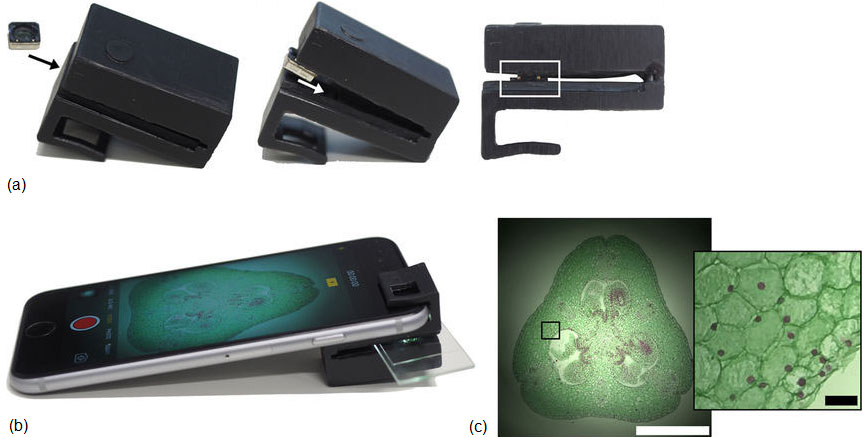Researchers from the Australian Research Council (ARC) Centre of Excellence for Nanoscale BioPhotonics have developed a smartphone microscope that uses the camera’s internal flash as the light source. Their development, described in Scientific Reports (February 2018), is not the first smartphone microscope. It is, however, the first smartphone microscope that does not require an externally powered light source. Consisting of only two parts—a 3D-printed clip and a lens—it is simple and inexpensive to produce. See also: Cellphone cameras; Lens (optics); Materials science and engineering; Microscope; Optical microscope

The clip serves two functions. First, it holds a lens, which functions as the objective lens of the microscope’s lens system. In a two-lens microscope, the lens closest to the specimen is called the objective, and the one nearest the eyepiece—or camera, in this case—is called the ocular. The second function of the clip is what makes the device unique; that is, it routes the light from the flash to the specimen positioned over the camera via a tunnel system. This is necessary because the flash is offset from the camera by almost one centimeter. The tunnel system is also unique because no mirrors or reflective surfaces are used. The tunnel wall is simply the 3D-printed, black photopolymerized acrylic resin of the clip. See also: Polyacrylate resin
The microscope has enough magnification to image red blood cells, which are about six to eight micrometers in diameter. As a result, the researchers believe it may find application as a low-cost microscope for use outside the laboratory, such as analyzing drinking water for microorganisms and organic or inorganic debris as well as for other biological fieldwork. If that weren’t enough, with the flash off, the device functions as a dark-field microscope for imaging transparent cells and materials. And if camera’s video function is activated, the device can be used for video microscopy. See also: Video microscopy
In addition, you can turn your smartphone into a microscope, because the researchers have made the technology free to all by sharing the 3D-printing files. The lens they used was from the back camera of a used (junk) iPhone 5s purchased for Australian $15 (about U.S. $12). If you cannot locate an inexpensive used smartphone, you might consider purchasing an iPhone 6 replacement back camera, which costs only a few more dollars.





